
A mimeograph machine was a low-cost duplicating machine that worked by forcing ink through a stencil onto paper. The process was called mimeography, and a copy made by the process was a mimeograph.
The General Electric Company (GEC) was a major British industrial conglomerate involved in consumer and defence electronics, communications, and engineering.
Duplicating machines were the predecessors of modern document-reproduction technology. They have now been replaced by digital duplicators, scanners, laser printers and photocopiers, but for many years they were the primary means of reproducing documents for limited-run distribution. The duplicator was pioneered by Thomas Edison and David Gestetner, with Gestetner dominating the market up until the late 1990s.
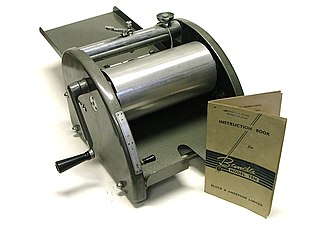
A spirit duplicator is a printing method invented in 1923 by Wilhelm Ritzerfeld that was commonly used for much of the rest of the 20th century. The term "spirit duplicator" refers to the alcohols that were a major component of the solvents used in these machines.

Electrolux AB is a Swedish multinational home appliance manufacturer, headquartered in Stockholm. It is consistently ranked the world's second largest appliance maker by units sold, after Whirlpool.
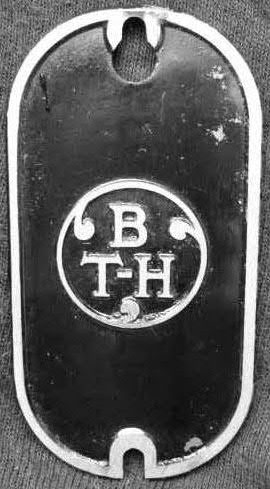
British Thomson-Houston (BTH) was a British engineering and heavy industrial company, based at Rugby, Warwickshire, England. Originally founded to sell products from the Thomson-Houston Electric Company, it soon became a manufacturer using licences from the American company. They were known primarily for their electrical systems and steam turbines.

Saab Automobile AB was a car manufacturer that was founded in Sweden in 1945 when its parent company, Saab AB, began a project to design a small automobile. The first production model, the Saab 92, was launched in 1949. In 1968 the parent company merged with Scania-Vabis, and ten years later the Saab 900 was launched, in time becoming Saab's best-selling model. In the mid-1980s the new Saab 9000 model also appeared.

American Type Founders (ATF) Co. was a business trust created in 1892 by the merger of 23 type foundries, representing about 85 percent of all type manufactured in the United States at the time. The new company, consisting of a consolidation of firms from throughout the United States, was incorporated in New Jersey.

The Gestetner is a type of duplicating machine named after its inventor, David Gestetner (1854–1939). During the 20th century, the term Gestetner was used as a verb—as in Gestetnering. The Gestetner company established its base in London, filing its first patent in 1879. The business grew, remaining within the control of the Gestetner family, and acquiring other businesses. In 1995, the Gestetner company was acquired by the Ricoh Corporation of Japan.

A waffle iron or waffle maker is a kitchen utensil used to cook waffles between two hinged metal plates. Both plates have gridded indentations to shape the waffle from the batter or dough placed between them. The plates are heated and the iron is closed while the waffle bakes. Waffles are a dessert with a light and sweet flavor, similar to pancakes. Their appearance is much harder to achieve than a pancake's without a waffle iron. Similar technology is employed to bake wafers, and several other snacks including kue gapit, a waffle-shaped but crunchy Indonesian snack which can be made with both sweet and savoury flavours.
Hotpoint is a brand of domestic appliances. Ownership of the brand is split between American company Whirlpool, which has the rights in Europe, Chinese company Haier, which has the rights in the Americas and Turkish company Arcelik which has rights in Russia and the CIS.
The Royal Typewriter Company is a manufacturer of typewriters founded in January 1904. It was headquartered in New York City with its factory in Hartford, Connecticut.
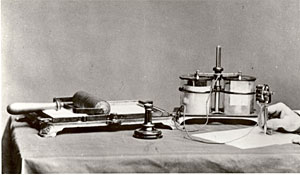
Thomas Edison's electric pen, part of a complete outfit for duplicating handwritten documents and drawings, was the first relatively safe electric-motor-driven office appliance produced and sold in the United States.
Paxman was a major British brand of diesel engines. Ownership has changed on a number of occasions since the company's formation in 1865, and the brand is now part of MAN Energy Solutions. At its peak, the Paxman works covered 23 acres (9.3 ha) and employed over 2,000 people. Early Paxman diesel engines carried the name Paxman Ricardo.
Albert Blake Dick was a businessman who founded the A. B. Dick Company, a major American copier manufacturer and office supply company of the 20th Century. He coined the word "mimeograph".

The Rock-Ola Manufacturing Corporation is an American developer and manufacturer of juke boxes and related machinery. It was founded in 1927 by Coin-Op pioneer David Cullen Rockola to manufacture slot machines, scales, and pinball machines. The firm later produced parking meters, furniture, arcade video games, and firearms, but became best known for its jukeboxes.
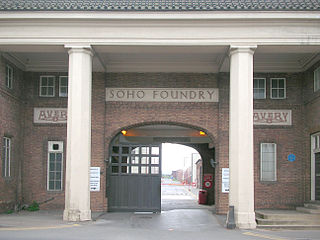
W & T Avery Ltd. was a British manufacturer of weighing machines. The company was founded in the early 18th century and took the name W & T Avery in 1818. Having been taken over by GEC in 1979 the company was later renamed into GEC-Avery. The company became Avery Berkel in 1993 when GEC acquired the Dutch company Berkel. After the take over by Weigh-Tronix in 2000 the company was again renamed to be called Avery Weigh-Tronix with Avery Berkel continuing to operate as a brand. The company is based in Smethwick, West Midlands, United Kingdom.

The automotive industry in Sweden is mainly associated with passenger car manufacturers Volvo Cars and Saab Automobile but Sweden is also home of two of the largest truck manufacturers in the world: AB Volvo and Scania AB. The automotive industry is heavily dependent on export as some 85 percent of the passenger cars and 95 percent of the heavy vehicles are sold outside of Sweden. The automotive industry and its sub-contractors is a major part of Swedish industry. In 2011 around 110,000 people were employed and the export income of 150 billion SEK accounted for 12 per cent of Sweden's export income. During 2009 128,738 passenger cars and 27,698 heavy vehicles were built in Sweden. Koenigsegg is also a famous Swedish company which makes some of the fastest cars in the world, but also some of the most expensive. They currently produce models such as the Jesko, Gemera, and CC850.
Great Dane, formerly known as Great Dane Trailers, is a Chicago, Illinois based manufacturer of truck dry van, refrigerated van and flatbed semi-trailers. Established in 1900 by J.P. Wheless and T.H. McMillan as the Savannah Blowpipe Company in Savannah, Georgia, it has gone on to become one of the world's largest manufacturers of commercial truck trailers.
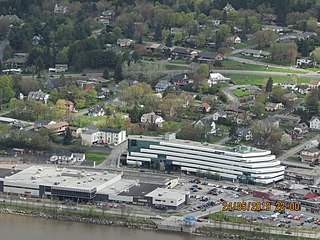
Manac is a Canadian manufacturing company that concentrates its activities in the conception and manufacturing of semi-trailers. Manac is the biggest manufacturer of trailers in Canada and is also one of the most important manufacturers of custom-built trailers in North America. They are the 7th biggest manufacturer of semi-trailers in North America. Manac's target market within the trucking industry is of custom-built units. Its products are sold under the brand names: Manac, CPS, Peerless, Darkwing, UltraPlate, Ultravan and Liddell Canada. The following brands give Manac a list of 125 various product offerings. The company was founded as a way of supplying Canam Steel Works, a company under the operation of its founder, Marcel Dutil. Its headquarters are located in Saint-Georges, Quebec while having factories in Penticton, British Columbia and Oran, Missouri.












